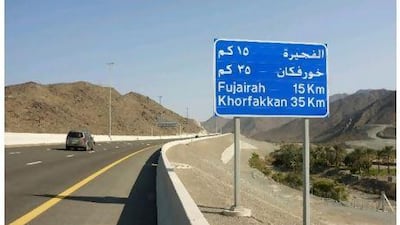FUJAIRAH // A three-lane motorway between Dubai and Fujairah opened yesterday, halving the driving time between the cities.
The road - which will allow the journey from Fujairah to Dubai to be completed in just an hour - is expected to greatly reduce the number of deaths caused by lorries and potholed roads.
Road accidents are one of the biggest killers in the rural area, from which many commute to work in Abu Dhabi and Dubai.
"Any new roads change life for people in the area," said Hessa Al Malek, the director of roads department for the Ministry of Public Works. "Soon we will see that all the villages along the way will be more developed, because it will reduce their journey by half and they will have more employment opportunities in Dubai."
The Dubai-Fujairah motorway is part of the ministry's strategy to develop remote areas, which remain isolated despite being home to tens of thousands of Emiratis in the north.
The 40km, Dh1.7billion motorway, on which construction began in June 2006, replaces a scenic two-hour meander through Dhaid and the sloping curves of the donkey-dominated Masafi mountains.
The new road is built for speed: 120kmh to be exact. They call it "extreme engineering".
"It's a mountain moving project," said Nicolas Ayiannitis, a project manager for National Wheel J&P, one of the project's three contractors. "It's the limits of extreme engineering. It's unique, there's no bigger cuts [in the rock] than that in the whole UAE."
The road begins on the outskirts of Fujairah city, cutting straight through the Hajjar mountains and over steep wadis for 26km before opening out to the gravel plains near Mleihah.
It features 100metre gashes through the mountain stone, 70m embankments in wadis, soil walls more than 60m tall and tunnels made for Fujairah's flash floods.
"The mountain area is just stunning," said John Weir, the senior project manager of the Dubai-Fujairah Freeway Project.
"Obviously the section through the mountains was particular challenging, with the suitable blasting and rock excavation and reinforced soil walls in order not to block off the wadis."
Blasting was controlled so the fragments of exploded rock would be the right size to use in the embankments. Some 13 million cubic metres of rock were excavated from mountains and 14 million cubic metres were used for embankments.
"A huge amount of rock has to be removed in order to reach the final profile of the road," said Mr Ayiannitis. "It was one of the most challenging activities for this project."
A single blast could remove between 5,000 and 15,000 cubic metres of soil and rock. Cut roads were stepped every eight to 10 metres for safety.
To manage the variety of rock found in Fujairah's mountains, a fourth contract was awarded last March to a company tasked solely with stabilising the rock cuttings.
To do that, the contractor employed - and will continue to employ for several months yet - netting, rock anchors, blots and barriers, as well as thousands of steel rods, each between three and six metres long and 30mm in diameter, piercing the mountain.
To cope with the flash floods of the wadis, the soil walls have four by four metre concrete boxes in every area where the road crosses a wadi that take the water underneath the road.
There are nine bridges, including one for camels near Malaiha. Bridges over the water and gas pipelines offer views of villages, white mosques and palm gardens tucked into the wadis. Heavy lorries will not be allowed to use the road.
It was built by about 3,400 workers from India, Thailand, Pakistan, Sri Lanka and Bangladesh.
Staff and engineers included Filipinos, Indians, Arabs and Europeans.
And the entire length of the road will be lit, thanks to more than 40km of 11-kilovolt cabling.
The bridge officially opened with a five-kilometre fun run attended by more than 600 runners yesterday.
azacharias@thenational.ae

New motorway will halve journey from Fujairah to Dubai
Three-lane road is a feat of engineering, slashing through mountains and making for a far easier commute.
Most popular today
